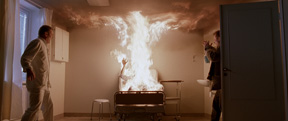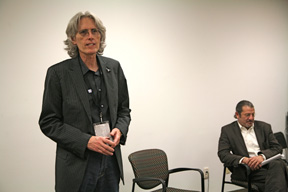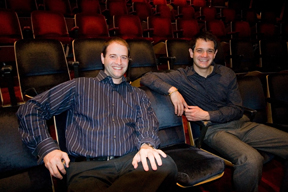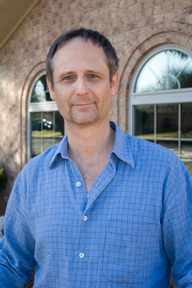Two years in, Fort Worth is getting a good buzz from its film festival.
By KRISTIAN LIN
So this is what we were missing. After a five-year drought, Fort Worth revived its civic celebration of the movies last year, under the new name of the Lone Star International Film Festival. Locals who stood in the lobby of the AMC Palace 9 during the festival in November 2007 and again in November 2008 could feel a change in the atmosphere.
They could hear the difference. The Palace isn’t a stranger to crowds; sometimes patrons line the lobby during the opening weekend of a hotly anticipated Hollywood blockbuster. Still, those crowds tend to be subdued, patiently waiting for the ushers to let them into the auditorium so they can take their seats. By contrast, the crowds at the festival filled the downtown theater with chatter that was amplified by the low ceiling on the theater’s ground floor. Part of the noise came from volunteers telling people where to line up and festivalgoers asking about the locations of tickets or programs or directions around the downtown area. Mostly, though, the buzz emanated from movie fans talking directly to attending filmmakers, discussing which films at the festival had impressed them so far, or eagerly looking forward to the chance to see a movie with recognizable stars before the rest of the country got a look at it.
It was an atmosphere that can’t be duplicated at home with a stack of DVDs. Indeed, aside from Bass Performance Hall when there’s a classical-music superstar in town, there are few cultural venues in Fort Worth that can match the Lone Star for this combination of electricity and artistic cachet.
Will it last, though? That question is on the minds of moviegoers who remember the end of the old Fort Worth Film Festival, especially with the country facing a large-scale economic downturn. Now that the initial excitement of simply getting the festival off the ground is wearing off, what’s being done to set the event up for the future? The answers to those questions are in the hands of a motivated crew with connections in Hollywood but deep roots in Texas.
Full disclosure: I served on the judging panel for the first Lone Star International Film Festival in 2007. The work, which involved watching many of the movies on DVD screeners in the days leading up to and during the festival, kept me from writing about it at the time but didn’t prevent me from catching many of the films in the theater.
The inaugural festival ran fairly smoothly, with few hitches beyond a memorable one on the last night, when it was discovered that only one reel of the festival-closing film, Grace is Gone, had been delivered. Otherwise, the crowds turned out for such marquee attractions as Sidney Lumet’s heavily praised Before the Devil Knows You’re Dead and Scott Prendergast’s little-seen but generally well-reviewed comedy Kabluey. Fort Worth favorite son Bill Paxton turned up for the premiere of The Good Life, an independently made drama in which he had a prominent supporting role. Reviewing the festival for Fort Worth Weekly, Cole Williams singled out the documentary Absolute Zero (“one that I’ll take to my grave”) and the Filipino horror flick Signos (“scared the bejesus outta me”) for praise.

Retrospectives of their work occasioned visits from the likes of Martin Sheen, Harry Dean Stanton, and Keith Carradine. One festival party brought in luminaries T-Bone Burnett and Robert Rodriguez. “The party was huge, probably the hugest of its kind ever in Fort Worth,” the Weekly’s Anthony Mariani wrote at the time. “The line was stretching down the block and around the corner … I saw enough to believe that our city is behind the Lone Star International Film Festival full-heartedly.”
Much of the festival’s original success can be credited to Tom Huckabee, who served as artistic director in 2007. The Fort Worth native with a gentle and courtly demeanor had been working in Hollywood on various projects with Paxton, his longtime friend. He met LSIFF chairman of the board Johnny Langdon during Paxton’s induction into the Texas Film Hall of Fame in 2007, and Langdon offered him a chance to get the new festival off the ground. At the time several of Huckabee’s family members were facing health problems back in North Texas, and it seemed like a good time to come home.
When it came to choosing international films, Huckabee had a mandate to let the local Sister Cities organization choose entries from the countries where Fort Worth has municipal partners. (The Sister Cities group no longer has such a heavy sway in the selection process.) As for the rest, his philosophy took shape early.
“I didn’t feel that Fort Worth was the place for an edgy, politically subversive festival,” he said. Instead, he noted the lack of art-house theaters in Fort Worth, as have many moviegoers before and since. “The Modern [Art Museum of Fort Worth] was really the only game in town, and there was a market that wasn’t being served.”
Starting from scratch meant that wasn’t the time to confine the festival’s programming to a single genre or aesthetic agenda. “I felt we had to get a sense of what kind of festival Fort Worth wants. You do that by keeping good statistics and refining it as you go through the years.” This doesn’t necessarily mean a narrowing of focus; Huckabee pointed out that Seattle and Chicago have large film festivals that present hundreds of movies designed to appeal to all kinds of audiences. “I like that,” he said. “They give you a smorgasbord of films that can’t easily be seen” otherwise.
He readily admitted that the initial festival made some rookie mistakes. “We learned to be careful about programming during the day on weekdays,” he said. Still, it came as a surprise when the board of the Lone Star Film Society (the organization that puts on the festival) didn’t renew his contract in early 2008. “I’m not sure what the cause was,” he said. “I was told that I’d done a great job with minimal budget and preparation time. I was never given any official criticism.” The flap occasioned sniping on the blog www.Westandclear.com, and several board members resigned. Paxton also severed ties with LSIFF.
J. Mitchell Johnson, who during the rest of the year produces films through his company Abamedia, is the president of the film society board. He also works extensively in Russia, archiving that country’s cinematic history. (His connections there were responsible for the selection of Russian films that played at this year’s festival.) He remembered what made Huckabee such an attractive candidate.
“He had festival experience, an artistic sensibility, and contacts in the industry. It was a win-win situation for us,” he said. While he wouldn’t go into particulars about that tumultuous time, he did say it was a “gut-wrenching” decision to let Huckabee go. “The board and Tom didn’t share the same vision of what the festival should be, and we had to agree to disagree,” he said, noting that there was never a long-term commitment to the outgoing artistic director. He quickly added, “We love the job that Tom did. We want to build on what he started,” referring to their shared goal of creating a film festival with something for all audiences.
Huckabee, for his part, is equally keen to emphasize that he harbors no hard feelings. On opening night of this year’s festival, artistic director Dennis Bishop stopped in the middle of his pre-film speech to pay tribute to Huckabee – who was sitting in the audience as an invited guest – and asked the crowd to applaud him. This gesture of reconciliation was as compelling in its own way as much of the onscreen drama that the festival had to offer.
“This year’s festival was very well organized, and the programming was excellent,” said Huckabee, who attended five films. “I hope it gets bigger and better.”
The people in charge of that will be Bishop, programming director Alec Jhangiani, and managing director John Storm. I met with them in LSIFF’s new offices on Forest Park Drive. They’re all pretty relaxed now that the next festival is 11 months away, but there was still a great deal of energy in the room. Jhangiani and Storm are young guys at 28 and 33 respectively, while Bishop is so trim and purposeful that I was surprised to learn that he’s 60. They all have deep ties to Texas, they all believe passionately in the festival, and their serene belief that they’re on the right course lit up the conference room on a miserably overcast afternoon.
The trio had just returned from Las Vegas, where they attended the International Film Festival Summit, a conference of organizers from around the world that included representatives from all the big names (Cannes, Sundance, Telluride, TriBeCa). “It was really worthwhile to network,” said Jhangiani, a University of Texas graduate who has been with the festival since its inception and brings a connoisseur’s eye to his movie viewership. “There’s a lot of commonality there. We have the same goals and the same troubles.” LSIFF also picked up an award for its program guide, judged the best among festivals in Lone Star’s size and budget range.
A native of Dallas, Bishop started out in the film business in the early 1980s,
 working on Texas-made films such as Local Hero as a location manager and The Trip to Bountiful as a line producer. In 1990 HBO Pictures (now HBO Films) hired him as a vice president of production. Since then he has split time between North Texas and Santa Monica, Calif., though he spent most of the past year here. He has since left HBO and produced films and TV shows independently, most notably two episodes of Dexter, the serial-killer drama on Showtime. Johnson brought him in to produce some of the 2007 festival’s panel discussions. Bishop wound up handling much of the coordination and budget work for the fest, while Huckabee worked on programming and attracting talent. In the wake of Huckabee’s departure, the board asked Bishop to take over.
working on Texas-made films such as Local Hero as a location manager and The Trip to Bountiful as a line producer. In 1990 HBO Pictures (now HBO Films) hired him as a vice president of production. Since then he has split time between North Texas and Santa Monica, Calif., though he spent most of the past year here. He has since left HBO and produced films and TV shows independently, most notably two episodes of Dexter, the serial-killer drama on Showtime. Johnson brought him in to produce some of the 2007 festival’s panel discussions. Bishop wound up handling much of the coordination and budget work for the fest, while Huckabee worked on programming and attracting talent. In the wake of Huckabee’s departure, the board asked Bishop to take over. In early 2008, Bishop and others spent time talking to various cultural organizations to determine what the festival should be, including the museums, Texas Christian University and University of Texas at Arlington, the mayor’s office, and even Fort Worth Weekly. (“The Star-Telegram never returned our calls,” said Bishop.) They talked to the convention and visitors’ bureau in order to avoid scheduling the festival at a time when downtown was busy with some other event. But they also needed the bureau’s help in thinking about how the festival could showcase the city to outsiders, an idea echoed by everyone I talked to.
“One filmmaker said he got directions around downtown from a stranger,” said Storm. “He said that wouldn’t have happened in New York or L.A.”
This year, Eric Bricker (the director whose Visual Acoustics took the “best documentary film” award) walked all the way from downtown to the Modern as a way of seeing the city. Showing off Fort Worth’s cultural treasures is the reason LSIFF continues to schedule films at the Kimbell Art Museum and the Modern. Still, most of the festival’s activity probably will continue to center on Sundance Square. “You can park your car and not have to move it while you eat at restaurants or look at the architecture downtown,” said Bishop. “Lots of our visitors loved the Sid Richardson Museum. They had no idea there was all this stuff in such a small area.”
The job of directing traffic, doling out badges, and putting out festival programs and drinking water for people largely fell to Storm, a 10-year Air Force veteran and Dallas native who “fell in love with Fort Worth” while stationed at Carswell Air Force Base from 2005 to 2007. Because he had done logistics for the military, his organizational skills proved invaluable. “We had to make the Lone Star Film Society a viable, sustainable business,” he said. “We needed a business plan. We needed to know how to handle taxes and payroll and create documents for the board to help them raise money. The board needs to establish an overlying vision, and not be painting fences” – that is, not do the grunt work.
Storm is more than just a bean counter, though; he clearly grasps the power of cinema. He recalled showing They Came to Play, Alex Rotaru’s documentary about the 2007 Van Cliburn amateur piano competition, to a group of school kids at the Imagination Celebration. “These were inner-city kids who had little exposure to classical music, and they were totally quiet while they were watching. When it was over, they had all these questions about the Cliburn. Film can be a powerful gateway to the other arts,” he said. The film, which profiles the contestants in this competition of older nonprofessional musicians, also played at the festival as part of the documentary competition.

Storm couldn’t forestall every organizational problem, though. “When AMC made the decision to close down the Sundance theater [in January 2008], they didn’t know until months later whether the Palace would have room for us,” said Bishop. “It put us behind.” The delay hampered organizers’ ability to sign up stars for personal appearances, and it kept them from unveiling their schedule of movies until a week before the festival began. In 2009, LSIFF officials hope to be able to announce its program of movies a month ahead of time.
Jhangiani also pointed out that the LSIFF thus far has focused on emerging actors rather than established stars. The festival in both years has given awards to emerging actors (Jason Ritter in 2007, Melonie Diaz in 2008). In doing so, organizers hope that some of their young honorees will become major stars and remember Fort Worth as the place where stardom started to happen for them and that festival fans will be able to say they knew ’em when. “We’ve told people in L.A. that this is going to be our focus,” he said.
Organizers also plan to keep a place open for local filmmaking talent, though Bishop stressed, “We won’t show films just because they’re from Fort Worth. If a filmmaker’s movie is no good, it won’t do any good to show his work.” This year, the Panther City Showcase, a sidebar series that screened at the new Norris Conference Center on the site of what used to be the AMC Sundance theater, offered a place for locally made films to show in a convivial atmosphere with audiences sitting on haphazardly arranged couches instead of traditional seats.
The mix of fare is in keeping with Huckabee’s original philosophy that LSIFF be a general-interest festival, appealing to all sorts of movie audiences.
 Is there a danger in programming in such an eclectic way? Bishop pointed to the Modern for his reply: “You can go there and see a Picasso, but you can also see the work of Teresa Hubbard and Alexander Birchler, who aren’t exactly household names but are a great emerging talent. We can do the same for film here.”
Is there a danger in programming in such an eclectic way? Bishop pointed to the Modern for his reply: “You can go there and see a Picasso, but you can also see the work of Teresa Hubbard and Alexander Birchler, who aren’t exactly household names but are a great emerging talent. We can do the same for film here.”While the team thinks that LSIFF will have more stars next year, they’re willing to go slow. “You don’t want to program a festival around a celebrity,” said Storm. “You want the fans to interact with the talent on an intellectual level, not just gawk at the actors walking down the street.”
Michael Cain, longtime artistic director of the AFI Dallas festival, agreed with that point of view. “Festivals shouldn’t sacrifice quality for celebrities,” he said. He attended LSIFF and recently gave a presentation at the Las Vegas summit on which barometers film festivals should use to measure success. For instance, he said, one shouldn’t read too much into the fact that there were fewer stars at the 2008 LSIFF than in 2007. “Stars are part of the picture, but sometimes they don’t show up for whatever reason,” he said. “You can’t control that. What you can control is programming. Good movies make audiences happy, send them away talking about the festival.”
On that score, the second LSIFF did well. Wendy and Lucy, Kelly Reichardt’s sparsely minimalist study of a woman on the brink of homelessness, screened at the Modern as part of the festival. It’s now showing up on critics’ lists of the year’s best films, as is Tomas Alfredson’s spooky Swedish vampire flick Let the Right One In, which played to a packed auditorium at a late-night screening. The opening-night selection was the low-budget dramedy Sunshine Cleaning, which is scheduled for a wide release in March.
Selections like those helped the festival boost its attendance from 8,000 in 2007 to 10,000 this year, with movies selling out in all the prime evening slots on Friday and Saturday. Local businesses were also buoyed by the visitors and film buffs.
“It was terrific,” said David Wilk, whose Four Day Weekend Theater hosted several screenings. “The Friday and Saturday night screenings were standing-room-only here. I think the festival introduced our theater to lots of people who’ve never seen it before.” The members of Four Day are filmmakers themselves, and they’re committed to partnering with LSIFF. “Anything we can do to further filmmaking in Fort Worth is something we’re happy to help out on.”
Though the Metroplex has been shielded from the worst of the recession, Cain said it’s no easy feat running a young festival in such times. “Many festivals go with fewer films or fewer days or smaller parties or lower ticket prices,” he said. “The important thing is not to overreact. Movie attendance tends to go up in hard times, because it costs much less to buy a movie ticket than to go to the opera or the symphony.”
Cain explained that a film festival requires faith not only from the ticket-buying public but also filmmakers (who trust the festival to show their work with good projection and sound and also turn out a crowd to see it), local businesses (which agree to hold parties and other functions), and the press. One of the most esteemed festivals in America – the Telluride Film Festival in Colorado – shows as many films as LSIFF does, he said. “It’s not about size. It’s about quality.”
What can we expect from the festival next year? Speaking only for himself, Lone Star Film Society board president Johnson said he is wondering about the possibilities of new media. “Shelf space is no longer an issue for movie distributors, because more and more films are going online. So how do you market these films with the new technology? How do you raise consciousness with audiences?” he said. “Facebook and MySpace are great ways to start a conversation. We need to bring in the best and the brightest to help us understand how.” He also envisions showing films from different countries each year and bringing in filmmakers from abroad to meet with their local counterparts.
LSIFF’s team is planning more events in 2009 like the premiere of They Came to Play that showed to a full and very appreciative house at the Modern last October. A year-round presence will raise the festival’s profile and, organizers hope, increase turnout for the big November event.
The Modern premiere was a joint venture with the Van Cliburn Foundation, one of many organizations with which LSIFF is forming alliances “Lone Star is building a network with the city,” said Cain. “It’s not about getting people to write checks, but gaining cultural partners. It’s important to have people who’ll be helping you in Year 3 or Year 5.”
The LSIFF team figures that a good foundation has been built. “Film is now a substantial art form after 100 years, but it’s still popular entertainment, too,” noted Jhangiani. “We’re hoping to bring that energy into Fort Worth, into the museums and the Van Cliburn, and present film as an art form on the same level. We can raise a pillar that’s been missing from the culture here.”











